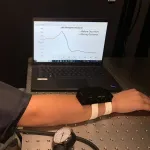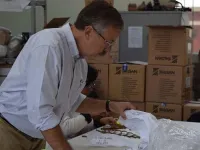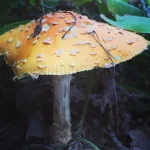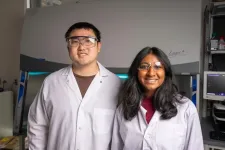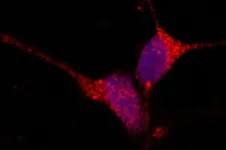(Press-News.org) Three independent state-of-the-art datasets reveal that the West Side has more nitrogen dioxide (NO2) pollution than the rest of the city
Depending on the month, residents in this area experience 16 to 32% higher NO2 concentrations on average
By identifying hotspots, residents and policymakers can be confident about where to prioritize immediate interventions
EVANSTON, Ill. — The western edge of Chicago — including the North and South Lawndale, East Garfield Park, Archer Heights and Brighton Park neighborhoods — experiences up to 32% higher concentrations of nitrogen dioxide (NO2) air pollution compared to the rest of the city, a new Northwestern University study has found.
In the new study, researchers developed a process to systematically identify areas of agreement and disagreement among three individual state-of-the-art air-quality datasets: satellite observations, a simulation developed at Northwestern and sensors from Microsoft Research’s Project Eclipse.
Although one or two datasets identified multiple areas as NO2 hotspots, all three datasets consistently flagged Chicago’s West Side as having elevated NO2 pollution. The West Side also has more Black, Hispanic and Latinx residents compared to the rest of the city, highlighting the disproportionate pollution and health burdens shouldered by these communities.
The study was published today in Environmental Research Letters.
“The three tools that we explored sometimes identified different areas of elevated pollution from one another,” said Northwestern’s Anastasia Montgomery, who led the study. “That doesn’t necessarily mean the tools are not working. It could be that they are looking at different things. However, in areas where we found agreement between the datasets, we have greater confidence that NO2 pollution is significantly high. The three different tools we used all pointed to the West Side as an area where pollution is significantly elevated relative to the Chicago average.”
“High spatial resolution air quality data has the potential to reveal inequitable exposure to pollution by identifying localized hotspots,” said Northwestern’s Daniel Horton, the study’s senior author. “Using this science-backed evidence, residents can advocate for change, and government officials can develop more targeted policies. By combining and improving tools to identify these hotspots, we can ensure that mitigation efforts serve the most affected communities.”
Horton is an assistant professor of Earth and planetary sciences at Northwestern’s Weinberg College of Arts and Sciences, where he leads the Climate Change Research Group. Montgomery recently completed her Ph.D. as a member of Horton’s research group.
To conduct the study, the researchers compared how each dataset quantified NO2. A byproduct of fossil-fuel combustion engines, NO2 is incredibly harmful to human health. Chronic exposure to these fumes can lead to bronchitis, pneumonia, asthma and even premature death. And under certain conditions, when NO2 interacts with sunlight, it can also produce ground-level ozone, which is linked to childhood asthma and other respiratory health issues.
Each tool in the study used a different method to gather data. Microsoft Research’s Project Eclipse collected real-time air-quality data by deploying 100 low-cost sensors throughout Chicago, which sampled the air every one minute. Previously developed in Horton’s laboratory, the Northwestern simulation combines emissions data with weather and chemical transport models to create neighborhood estimates of air quality. And the satellite tool takes a snapshot of Earth’s atmosphere once per day.
“Satellite tools are sensitive to different wavelengths of light,” Montgomery explained. “Nitrogen dioxide absorbs light at certain wavelengths, so satellite snapshots can reveal different levels of nitrogen dioxide concentrations across space.”
Because air pollution changes across seasons, the researchers looked at air quality data in February and August. Then, they pinpointed neighborhoods with high agreement (meaning all tools agree), medium agreement (two tools agree) and low agreement (consensus among none of the tools) regarding NO2hotspots.
All tools consistently identified the city’s West Side as a hotspot in both August and February, regardless of season or wind direction. Depending on the month, the estimated 501,000 people who live and work within this hotspot experience NO2 concentrations that are 16 to 32% higher than the city-wide average.
Data from satellites and Microsoft Research’s sensors also pinpointed an adjoining hotspot just a bit north of the consensus hotspot, encompassing the Austin, Humboldt Park and West Garfield Park neighborhoods. The Northwestern simulation, however, did not indicate a hotspot in this area.
“Our model does not simulate significantly high pollution concentrations here, but observations show otherwise,” Montgomery said. “Because the model simulations don’t agree with two observational datasets, it suggests that our model has limitations. Perhaps we need to adjust the model physics or the underlying emission estimates.”
Another area of medium agreement occurred along highways. While satellite data and the Northwestern simulation uncovered high NO2 along highways, the Microsoft Research data did not.
“We think that’s because most highways in Chicago are typically above street level,” Montgomery said. “Microsoft placed sensors at bus stops, which are always at street level, so they didn’t capture the elevated interstate corridors well.”
Even though the tools might disagree on hotspots, the causes behind the hotspots are certain. All areas with high or medium agreement are considered heavily trafficked and moderately to highly industrialized.
“Tools like those we used in this study can be used as complementary components for monitoring a city to show where targeted inventions are most needed,” Montgomery said. “We can look at the zoning there and who is being affected. Policies could be implemented to incentivize engine idling restrictions, building standards or the purchase of electric vehicles.”
The study, “Intraurban NO2 hotspot detection across multiple air quality products,” was supported by the National Science Foundation and Microsoft Research.
END
ROCKVILLE, MD – The Biophysical Society is proud to announce its 2024 Society Fellows. This award honors the Society’s distinguished members who have demonstrated excellence in science and contributed to the expansion of the field of biophysics. The Fellows will be honored at the Biophysical Society’s 68th Annual Meeting, being held in Philadelphia, Pennsylvania from February 10-14, 2024. The 2024 Fellows are:
Rommie E. Amaro, University of California, San Diego, USA, is named a Biophysical Society Fellow for her work on developing methods to enable the simulation of biological molecules in situ and ...
WASHINGTON — Researchers have developed a wearable optical device for early detection of hemorrhage during labor or after childbirth. This serious heavy bleeding can be hard to detect before it becomes an emergency and accounts for almost 30% of maternal deaths globally and just over 10% of maternal deaths in the United States.
Studies have shown that early diagnosis and treatment for postpartum hemorrhage is the best way to prevent deaths. The new device is designed to be worn on the wrist, where it uses laser speckle imaging to continuously ...
PORTLAND, Oregon -- The United States’ most distinguished biomedical research award is being given to Oregon Health & Science University physician-scientist David Huang, M.D., Ph.D., for co-inventing an imaging technology that routinely helps prevent blindness and is increasingly used to diagnose and treat conditions of the heart, brain, skin and more.
Huang is receiving the 2023 Lasker-DeBakey Clinical Medical Research Award as a co-inventor of optical coherence tomography, or OCT, the Albert and ...
Violence was a consistent part of life among ancient communities of hunter-gatherers, according to a new study co-authored by a Tulane University researcher that looked for signs of trauma on 10,000-year-old skeletal remains from burial sites in northern Chile.
The study was published in the journal PLOS ONE.
Archaeological research has shown that interpersonal violence and warfare played an important role in the lives of hunter-gatherer groups over time. Still, many questions remain about the factors that influence such violence. The record of human populations in northern Chile extends across 10,000 years, providing a valuable opportunity to study patterns in violence over time.
John ...
Children are taught to leave wild mushrooms alone because of their potential to be poisonous. But trees on the other hand depend on fungi for their well-being. Look no further than ectomycorrhizal fungi, which are organisms that colonize the roots of many tree species where the boreal ecosystem (zone encompassing Earth’s northernmost forests) and the temperate ecosystem (zone between the tropical and boreal regions) meet. This area features a mix of boreal trees including needle-leaved evergreens and temperate tree species including maple and oak.
Just like a healthy human relationship, trees and fungi work well together because they help one another. When the ectomycorrhizal ...
HOUSTON – (Sept. 21, 2023) – To make a gene-editing tool more precise and easier to control, Rice University engineers split it into two pieces that only come back together when a third small molecule is added.
Researchers in the lab of chemical and biomolecular engineer Xue Sherry Gao created a CRISPR-based gene editor designed to target adenine ⎯ one of the four main DNA building blocks ⎯ that remains inactive when disassembled but kicks into gear once the binding molecule is added.
Compared to the intact original, the split editor is more precise and stays active for a narrower window of time, ...
It sounds like magic: photoelectrodes could convert the greenhouse gas CO2 back into methanol or N2 molecules into valuable fertiliser - using only the energy of sunlight. An HZB study has now shown that diamond materials are in principle suitable for such photoelectrodes. By combining X-ray spectroscopic techniques at BESSY II with other measurement methods, Tristan Petit's team has succeeded for the first time in precisely tracking which processes are excited by light as well as the crucial role of the surface of the diamond materials.
At first glance, lab-grown diamond materials ...
Under normal circumstances, tau protein is part of the brain’s infrastructure, important for stabilizing neurons into their proper shapes. But sometimes tau gets knotted up into tangles and turns toxic, injuring brain tissue and causing tauopathies, a group of brain diseases characterized by problems with learning, memory and movement. Alzheimer’s disease is the most common tauopathy, but the group also includes Parkinson’s disease, chronic traumatic encephalopathy (CTE) and several rare genetic conditions.
In search of ways to prevent these destructive ...
A study has revealed new details about a key population of immune system cells critical to successful vaccination against the pandemic virus, SARS-CoV-2.
Led by researchers at NYU Grossman School of Medicine and New York Genome Center, the current study focused on T cells, which along with B cells, compose the human immune system’s response to invading viruses and bacteria. A subset of T cells, labeled with the surface protein CD8, produce molecules that directly kill infected cells. B cells produce antibody proteins that neutralize and label infected cells for removal from the body.
Without risking ...
Psychological loss can occur when someone loses a job, loses a sense of control or safety or when a spouse dies. Such loss, which erodes well-being and negatively impacts quality of life, may be a common experience but little is known about the molecular process in the brain that occurs because of loss.
New research from the University of Cincinnati explores those mechanisms through a process known as enrichment removal (ER). The study highlights an area of the brain that plays a key role in psychological loss and identifies new molecular targets that may alleviate its impact.
The research was published in the journal Molecular Psychiatry.
The research was led by Marissa Smail, a ...
